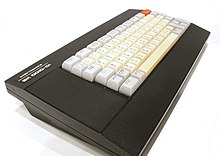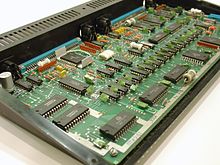Electronics BK-0010
The Elektronika BK-0010 ( Russian Электроника БК-0010) is a series of home computers that was manufactured in the Soviet Union from 1983 .
The BK-0010 was first mentioned in 1983, the date when the operating instructions were created. The computer was developed in the National Research University of Electronic Technology - Moscow Institute of Electronic Technology (MIET) in Zelenograd , near Moscow, and manufactured in the factory "exciton" in Pavlovsky Posad . The computer first appeared in stores in January 1985.
The BK-0010 is based on the 16-bit microprocessor K1801WM1 ( Russian К1801ВМ1 ) with a PDP-11 architecture. The CPU K1801WM1 was available in two versions: In a ceramic and a plastic housing. It worked with the frequency of 3 MHz, but there were no commands for multiplication and division. The computer architecture of the PDP-11 built by the Digital Equipment Corporation , one of the most successful mini-computers of the 1970s, found its way into a desktop device (similar to the TI990 and TI99 ).
The BK-0010 has 32 KB RAM and 32 KB ROM . In addition to a 16 KB area for the operating system, the ROM contains an area of the same size for an interpreter for the FOCAL programming language ( Russian Фокал , from English FOrmula CALculator ), which was first developed by the Digital Equipment Corporation for the PDP -6. A BASIC interpreter was available as an additional module.
It was possible to connect additional RAM (instead of the ROM with BASIC) or a network card via an external connection (industry standard QBus).
The graphic controller K1801WP1-037 ( Russian К1801ВП1-037 ) with 16 KB RAM allows the display in two modes: With a resolution of 256 × 256 pixels with four colors or 512 × 256 pixels with two colors (black / white). The image could be output via a monitor or a television set.
In addition to the video output, the interfaces include a connection for a standard cassette recorder for data storage (with 1200 Bd ), a serial RS-232 interface (with 50 Bd to 9600 Bd) and 16 input and 16 output lines.
The computer and the keyboard with 92 keys and a Cyrillic layout are located together in a housing with the dimensions 37 cm × 18 cm × 7 cm (similar to the C-64 ).
The programming in BK assembler was comfortable and pleasant: linear memory, 16-bit commands and addresses, all eight registers of the processor were equal (there was no division into index registers etc.)
The ceramic processor could be operated with up to 8 MHz and instead of the BASIC also manage fast (static) memory. One shortcoming was the slow dynamic graphics memory. It limited the practical processing speed to 5 MHz due to waiting cycles.
Additional devices quickly appeared: specialists such as Vadim Novak developed expansion cards that were produced in small series. A particularly successful development was a small expansion that combined a floppy disk controller, a Winchester drive, and 16 Kb of additional RAM. For this purpose, some powerful operating systems, text editors and other things were programmed that upgraded the BK-0010.
The successor model was the BK-0011, which already had 128 Kb of RAM. The video memory of the "БК-0011" was also increased: it now consisted of two alternating pages. The processor frequency has been increased to 4 MHz. The new model quickly achieved great popularity as an extended DOS was written for it and replaced the old system. The additional controller was still required to connect a hard disk drive ( "Winchester" ) and a floppy disk drive. In addition to hard disk drives and floppy disk drives, other external devices could be connected without great effort: printers, modems, mouse and joystick. Particularly talented people managed to build a 2 "hard disk drive and controller into the keyboard. The AY-3-8912 sound processor, known from the ZX Spectrum and the Yamaha MSX, was built into the BK. The cheapest way to improve the sound was this Installation of a Covox adapter .
A special feature of the computer was that it came onto the market without any software. Simple games, the Fokal interpreter that replaced BASIC, and a few test applications were practically everything. But documentation of the BASIC and the machine code appeared for the computer. Building on this, programmers like Vladimir Sawin wrote new games that they transferred from other platforms. Many one-man companies such as BIL Corp., SW Corp., RDA Corp. were no less respected among users than companies like Ocean Software , Electronic Arts , Virgin Interactive and Activision were important for systems like the ZX Spectrum .
At the beginning of the 1990s, programmers from Samara built an AY-3-8912 music processor into the further development BK-0011M and wrote a new operating system called CSI-DOS. From this a musician scene developed that used the computer as a sound machine.
Web links
- Old Computer Museum
- BK-0010 Nostalgia page
- Elektronika BK-0010 on Russian Home Computer Website
- BK-0010 on ebay with a detailed description ( memento from March 1, 2016 in the Internet Archive )

